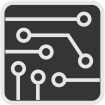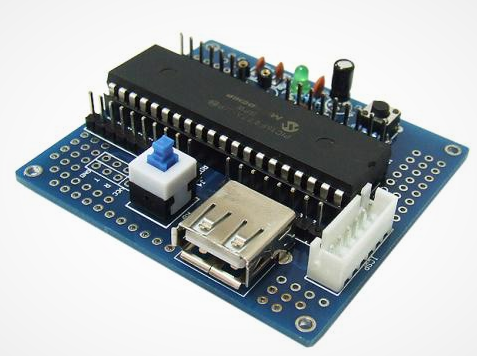Autor: mikroElektronika
An aparitie: 2004
Despre ce este vorba?
Unele dintre principalele avantaje ale compilatorului PIC mikroBasic este usurinta de utilizare si capacitatea de a face ca un proiect sa functioneze in cateva ore, in loc de zile sau saptamani.
Capacitatea de a programa un microcontroller in BASIC, este un „vis devenit realitate”. Mai mult, atunci cand limbajul BASIC este sub forma unui compilator, combina atat viteza, cat si usurinta de utilizare.
Compilatorul PicBasic Pro (PIC mikroBasic) permite controlul total asupra gamei de PIC-uri de 14 biti si 16 biti.
Structura lucrarii
CAP 1. The Basics
1.1 Why BASIC?
1.2 Choosing the right PIC for the task
1.3 A word about code writing
1.4 Writing and compiling your program
1.5 Loading program to microcontroller
1.6 Running the program
1.7 Troubleshooting
CAP 2. Elements of BASIC Language
2.1 Identifiers
2.2 Operators
2.3 Expressions
2.4 Instructions
2.5 Data Types
2.6 Constants
2.7 Variables
2.8 Symbols
2.9 Directives
2.10 Comments
2.11 Labels
2.12 Procedures and Functions
2.13 Modules
CAP 3. Operators
3.1 Arithmetic Operators
3.2 Boolean Operators
3.3 Logical (Bitwise) Operators
3.4 Relation Operators (Comparison Operators)
CAP 4. Control Structures
4.1 Conditional Statements
4.1.1 IF..THEN Statement
4.1.2 SELECT..CASE Statement
4.1.3 GOTO Statement
4.2 Loops
4.2.1 FOR Statement
4.2.2 DO..LOOP Statement
4.2.3 WHILE Statement
4.3 ASM Statement
CAP 5. Built-in and Library Routines
5.1 Built-in Routines
5.2 Library Routines
CAP 6. Examples with PIC Integrated Peripherals
6.1 Interrupt Mechanism
6.2 Internal AD Converter
6.3 TMR0 Timer
6.4 TMR1 Timer
6.5 PWM Module
6.6 Hardware UART module (RS-232 Communication)
CAP 7. Examples with Displaying Data
7.1 LED Diode
7.2 Seven-Segment Display
7.3 LCD Display, 4-bit and 8-bit Interface
7.4 Graphical LCD
7.5 Sound Signalization
CAP 8. Examples with Memory and Storage Media
8.1 EEPROM Memory
8.2 Flash Memory
8.3 Compact Flash
Bibliografie:


Inainte sa apara Arduino cu toata pleiada de placi, programam si eu PIC-uri. Pentru utilizatorii „casnici” sau hobbysti, lupta a fost pierduta de PIC..
Dar au cumpărat ATMEL..
In 2016, Microchip agreed to buy Atmel for US$3.6 (equivalent to $3.88 in 2020) billion in a deal brokered by JPMorgan Chase and Qatalyst.
In ce sens a fost pierduta lupta de PIC ?
Presupun ca limbajul lor de programare era mai greoi ca cel de la Atmel. Probabil asta a facut ca microprocesoarele Microchip PIC sa nu fie atat de populare..
Pentru orice tip de microcontroller exista compilatoare atat in C cat si in Basic. Programez in basic ESP32, Atmel si PIC. Eu zic ca multi fug de PIC-uri pt ca au la indemana librariile si exemplele pentru Arduino, e mai „mura-n gura” , dar sunt uC depasite. In automotive, nu am vazut Atmel (posibil sa fie ceva, dar rar) ci doar PIC-uri. Cu criza actuala la Microchip , automotivele au tras pe dreapta. Marea majoritate ale placilor electronice ale electrocasnicelor au PIC. Contoarele de energie electrica care se fabrica in acest moment au PIC. Nu am studiat atent , deci nu pot argument, dar STM32 nu cred ca au ceva peste DSPIC33CK . Eu vad cam asa: de ce sa lucrezi cu 16 biti cand nu stapanesti nici macar 8 biti ?
Eu il programam/programez in mikroPascal. Asa am inceput de prin 2005. MikroPascal, mikroBasic sunt limbaje mult mai prietenoase, insa nu se mai folosesc decat in cazuri foarte rare. C-ul a fost si este in continuare un limbaj mult agreat. Viitorul începe sa sune prin Python, un limbaj care am observat ca împrumuta ceva din cele 2 din urma combinat si cu C.
De cand am descoperit ESP nu am mai folosit Arduino cu AVR.
Asa este! Dar poti incerca si STM32 daca ai nevoie de viteze mari. Gen Cortex M7 spre exemplu. ?
microPython pe Rpi Pico nu e rău deloc, în privința ușurinței de utilizare, poți scrie cod direct în editor și să-l încarci pe uC.